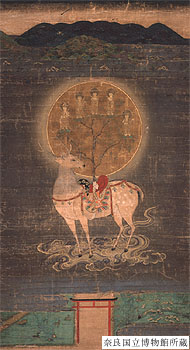 |
 |
|
Kamakura Period: 14th century Nara National Museum Enlarged Image... |
Muromachi Period: 14th century Nara National Museum Enlarged Image... |
Images of Nara as a Sacred Landscape
 |
 |
|
Kamakura Period: 14th century Nara National Museum Enlarged Image... |
Muromachi Period: 14th century Nara National Museum Enlarged Image... |
On the 17th day, 5th month, 3rd year of the Juei era (June 26, 1184 by the Julian calendar), Kujo Kanezane, a nobleman in Kyoto, received a painted scroll depicting Kasuga Shrine from a Buddhist priest in Nara. He wrote in his diary, Gyokuyo, that after purifying himself and dressing up, he gave his prayers and recited the Heart Sutra before the painting. His description tells us that images of the shrine were treated as objects of worship or the shrine itself.
By Noboru Ogata, Emeritus, Kyoto University
Reproduced by
courtesy of the
Nara National Museum. Unauthorized reproduction of the images
is prohibited.
![]()